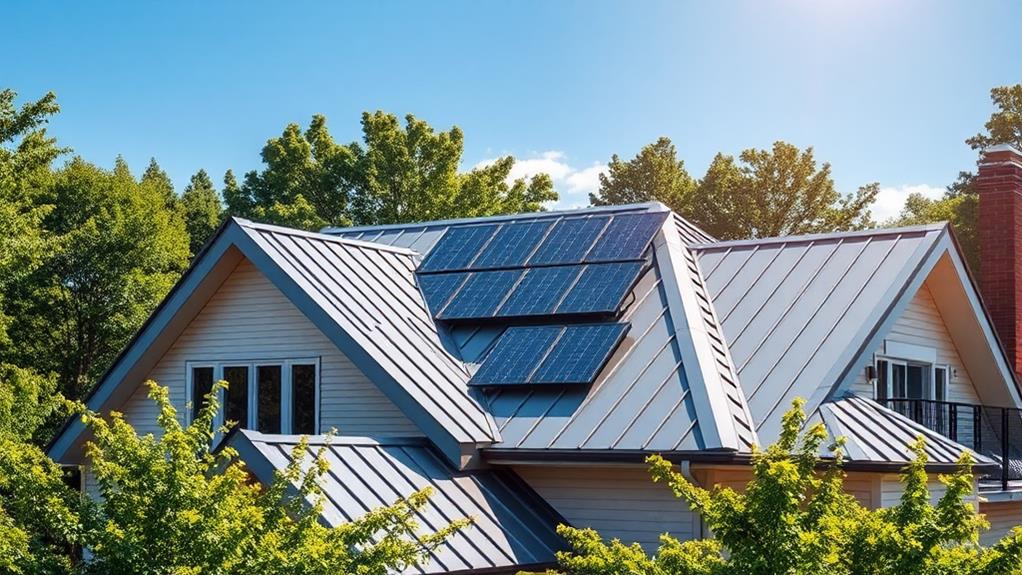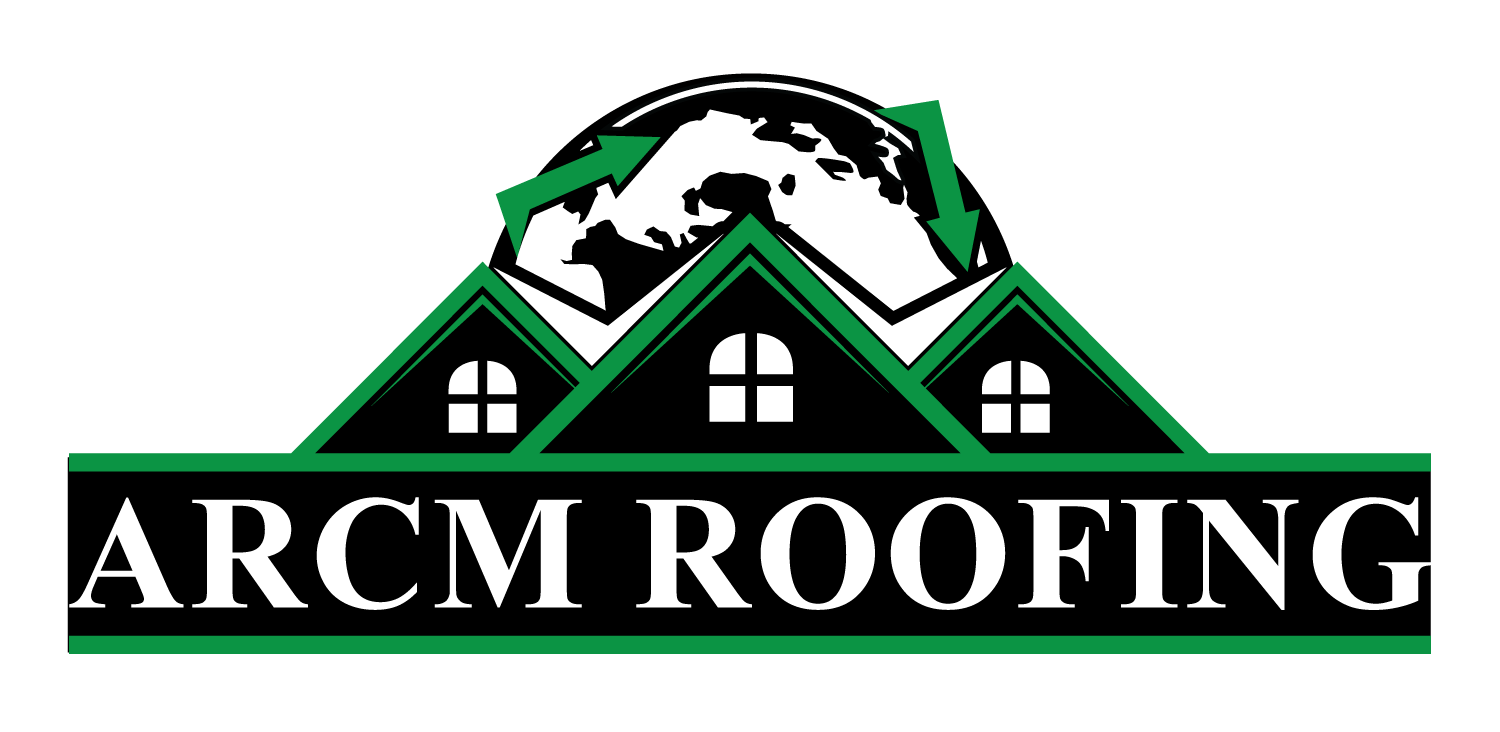Energy-efficient residential roofing integrates ideal materials and technologies to improve thermal performance while reducing energy usage. Cool roofs, with their reflective surfaces, drastically lower cooling costs and contribute to longer material lifespans. Options such as metal roofing, reflective shingles, and solar tiles provide substantial benefits, including reduced dependency on HVAC systems and improved energy independence. Effective insulation combined with proper ventilation guarantees indoor comfort and minimizes energy demands. In addition, embracing these environmentally-conscious choices can decrease the homeowner's carbon footprint. By exploring further, you can discover the array of choices and benefits available within this innovative roofing solution.
Roofing Highlights
- Energy-efficient roofs utilize materials that reflect sunlight and enhance thermal performance to lower energy consumption.
- Cool roofs, such as metal roofing, reduce cooling costs by absorbing less heat from the sun.
- Insulation and ventilation work together to maintain a stable indoor climate, minimizing heating and cooling demands.
- Solar tiles integrate with traditional roofs to harness solar energy and promote self-sufficiency.
- Energy-efficient roofs mitigate urban heat islands and reduce greenhouse gas emissions, promoting sustainable living.
Energy-Efficient Roofing Defined

Energy-efficient roofing encompasses a variety of materials and technologies designed to enhance thermal performance and reduce energy consumption in residential settings. Among these, cool roofs provide significant benefits by reflecting more sunlight and absorbing less heat than standard roofs, thereby decreasing cooling costs and extending the lifespan of the roofing materials themselves.
Additionally, affordable solutions accommodate both new construction and existing structures to optimize energy efficiency. Moreover, effective insulation and ventilation are indispensable components that work in tandem with energy-efficient materials to maintain indoor comfort and minimize heating and cooling demands.
Types of Energy-Efficient Materials
A variety of innovative materials are now available for homeowners seeking to install energy-efficient roofing, each designed to reduce energy consumption and enhance environmental sustainability. These materials have been engineered to reflect more sunlight and absorb less heat, making them practical options for creating a more comfortable indoor environment. Among the most prominent choices are metal roofing, reflective shingles, and solar tiles.
Metal roofing, known for its durability and longevity, provides excellent thermal performance by reflecting solar energy, consequently reducing cooling costs. It is available in various styles and colors, allowing homeowners to complement their existing architecture while reaping the benefits of energy efficiency.
Reflective shingles, meanwhile, are designed with granules embedded with advanced technology that reflects ultraviolet and infrared light, further aiding in energy reduction.
Another innovative solution is solar tiles, which integrate seamlessly with traditional roofing materials while harnessing solar energy to power the home. Though initially more costly, this option offers significant long-term savings and represents a step toward self-sufficiency. Each of these materials offers an opportunity not only to lessen environmental impact but to belong to a community committed to sustainable living, joining a collective pursuit of a greener future.
Benefits of Cool Roofs
Cool roofs offer a range of benefits for homeowners seeking to maximize energy efficiency and enhance indoor comfort. These roofs are designed with reflective surfaces that help reduce the absorption of heat from the sun. By minimizing heat penetration, cool roofs effectively lower the demand for air conditioning, leading to reduced energy consumption and cost savings. This is particularly beneficial in regions with warm climates, where the intensity of sun exposure can significantly impact indoor temperatures.
In addition to energy savings, cool roofs contribute to an improved indoor environment by maintaining lower thermal temperatures inside homes. This reduction causes less strain on heating, ventilation, and air conditioning (HVAC) systems, helping them operate ideally and prolonging their lifespan.
Additionally, cool roofs can play a critical role in mitigating urban heat islands by reducing ambient temperatures in densely populated areas, enhancing the overall quality of life for communities.
Further, they offer an eco-friendly solution, reflecting more sunlight and absorbing less heat than standard roofing systems, which reduces greenhouse gas emissions. Aiding in sustainability, these roofs can complement residential solar panels, improving their efficiency and making a meaningful contribution to a home's energy independence.
Insulation and Ventilation Importance
While cool roofs greatly enhance energy efficiency, the role of proper insulation and ventilation is equally essential in the domain of energy-efficient roofing. A comprehensive approach to residential roofing necessitates attention to these components to guarantee a harmonious reduction in energy consumption.
Insulation acts as a barrier, controlling heat flow between the interior of the home and the external environment, thereby maintaining a stable indoor climate. Effectively insulated roofs retain warmth during colder months and inhibit heat gain during warmer periods, contributing significantly to reduced energy demand for heating and cooling systems.
Ventilation complements insulation by facilitating adequate airflow, which prevents moisture build-up and reduces the risk of mold and material degradation. By expelling hot air and drawing in cooler air through passive or active ventilation systems, roofs are maintained in ideal conditions, promoting longevity and efficiency.
Together, these elements contribute to a structure that aligns with sustainable living standards by reducing energy usage and aligning with the community's broader environmental goals. As a result, while selecting energy-efficient solutions, homeowners collectively benefit from a shared sense of responsibility towards energy conservation, fostering a community committed to sustainable development and environmental harmony.
Benefits

Investing in residential roofing not only contributes to substantial reductions in energy bills but also dramatically enhances overall home comfort by optimizing thermal efficiency. With expert residential roofing services available in the Denver metro area, homeowners can access industry-leading materials that provide superior impact resistance and weather protection.
This essential home upgrade acts as a barrier against extreme weather conditions, which reduces the need for excessive heating or cooling. In addition, environmentally-conscious choices in roofing materials and designs can lead to a marked reduction in the home's carbon footprint, aligning with sustainability goals and fostering a healthier planet.
Lower Energy Bills
A well-installed residential roofing system can play a significant role in lowering energy bills, delivering tangible financial benefits. By selecting materials and designs that optimize thermal regulation, homeowners can achieve significant energy savings.
Modern roofing technologies often utilize reflective surfaces or advanced insulation materials that minimize heat absorption during hot months and retain warmth during colder seasons. This leads to a decreased reliance on artificial heating and cooling systems, which directly translates to reduced utility costs.
Furthermore, energy-efficient roofing contributes to a broader economic impact by enhancing the property's overall value. As potential homeowners increasingly prioritize sustainability and cost-efficiency, investing in an energy-efficient roof can make a residence more appealing in a competitive market. Many communities, recognizing the collective importance of energy reduction, offer incentives, rebates, or tax credits to encourage such eco-friendly upgrades, further softening the financial burden of initial installation.
The process of shifting to energy-efficient roofing involves consultation with professional roofing contractors who can assess individual needs and offer tailored solutions. Their expertise ensures that the chosen roofing system not only complies with local building codes but also aligns with the homeowner's specific goals for energy efficiency and financial prudence.
Enhanced Home Comfort
In addition to lowering energy bills, energy-efficient residential roofing dramatically enhances home comfort. By regulating indoor temperatures, such roofing systems mitigate temperature fluctuations that often lead to discomfort. The effective insulation properties inherent in energy-efficient roofing prevent excessive heat penetration during summer and hinder heat escape during winter. This creates a consistently pleasant indoor climate for occupants, reducing reliance on heating and cooling systems and fostering a serene and cozy environment.
The enhanced comfort stemming from energy-efficient roofing is further accentuated by the integration of advanced roofing materials designed to reflect more sunlight and absorb less heat compared to conventional roofs. These reflective capabilities contribute to maintaining cool and comfortable home interiors, especially during warmer months, thereby strengthening the sense of belonging and sanctuary within one's living space.
Additionally, energy-efficient roofing systems often incorporate soundproofing features, which effectively attenuate outdoor noise. This facet is particularly beneficial for homes situated in bustling urban areas, contributing to a tranquil and undisturbed dwelling. For individuals seeking a refuge from external stressors, energy-efficient roofing provides reassurance and peace of mind, facilitating a wholesome living experience that aligns with aspirations of comfort and well-being in the domestic sphere.
Environmental Impact Reduction
Energy-efficient residential roofing remarkably contributes to environmental impact reduction. By incorporating advanced materials and technologies, these roofing solutions dramatically decrease the carbon footprint associated with energy consumption in homes. Roofs equipped with reflective surfaces or integrated solar panels mitigate the urban heat island effect, thereby lowering ambient temperatures and reducing reliance on air conditioning. This directly translates into less energy demand and, consequently, fewer greenhouse gas emissions.
Moreover, the deployment of eco-friendly roofing materials, such as recycled metal, sustainable wood shingles, and photovoltaic tiles, plays an essential role in minimizing waste and promoting resource conservation. The reduction of waste going to landfills and the use of materials that endure longer than traditional asphalt shingles contribute to resource efficiency.
This sustainability is further enhanced by roofing systems designed to optimize water runoff and promote rainwater harvesting, fostering a more responsible use of water resources.
In a community working towards environmental stewardship, embracing energy-efficient roofing not only signifies a commitment to sustainability but also aligns individual households with broader ecological goals. This communal adoption fosters a shared identity centered on protecting the planet, joining individuals together under the banner of responsible living.
Available Tax Credit Options

Understanding the array of tax credit options available for residential roofing projects is vital for homeowners aiming to maximize their financial efficiency. Federal tax incentives often provide substantial savings, while state-specific programs may offer additional credits, creating a multi-layered opportunity for financial benefit. Proper navigation through eligibility and application processes guarantees that homeowners can effectively capitalize on these incentives, as outlined in the following table:
| Tax Credit Option | Key Features |
|---|---|
| Federal Tax Incentives | Nationwide applicability, renewable |
| State-specific Credit Programs | Additional, varying by state |
| Eligibility Requirements | Income levels, roofing material types |
| Application Process Details | Documentation needs, deadlines |
| Combined Benefits | Potential for significant cost savings |
Federal Tax Incentives
For homeowners considering roof renovations, federal tax incentives provide a compelling advantage by offering monetary relief through available tax credit options. These incentives are designed to promote energy efficiency by alleviating some of the initial costs associated with installing energy-efficient roofs.
Such tax credits typically encompass materials like metal and asphalt roofs that include pigmented coatings and cooling granules designed to reflect more sunlight and lower roof temperatures.
The federal Residential Energy Efficient Property Credit, under the Consolidated Appropriations Act, allows homeowners to claim a percentage of the installation costs. For roofing, this credit can substantially ease the financial burden involved in the upfront costs of adopting environmentally friendly options. Homeowners must guarantee that the roofing materials they choose meet ENERGY STAR requirements to qualify for these incentives.
Moreover, the federal government extends these tax incentives as part of a larger strategy aimed at reducing national energy consumption, underscoring a collective push towards sustainability. The outlined qualifications and procedures mitigate barriers, encouraging community participation in environmental stewardship. By utilizing these resources, homeowners not only reduce energy bills but also contribute to collective efforts in combating climate change, fostering an inclusive sense of belonging within a global initiative.
State-specific Credit Programs
How can homeowners maximize savings on roof renovations? One of the pivotal strategies lies in leveraging state-specific credit programs, which augment the federal tax incentives already discussed. These state-specific initiatives are designed to promote energy efficiency by offering financial relief to homeowners investing in sustainable roofing technologies.
Each state crafts unique programs, reflecting local environmental goals and budgetary frameworks, consequently providing a diverse spectrum of benefits tailored to residents' needs. Homeowners yearning to reduce their renovation costs while contributing to environmental conservation will find these programs invaluable.
For instance, certain states offer tax credits that can be applied towards solar roofing installations, while others provide rebates for the use of reflective materials that enhance energy efficiency. By participating in these programs, community members can align their financial strategies with broader sustainability objectives, fostering a sense of cohesion and shared responsibility for environmental stewardship.
Engaging with these state-specific programs necessitates a thorough understanding of local offerings, which can vary considerably. This includes awareness of deadlines, percentage reductions, and the types of roofing materials or systems that qualify. Homeowners, as a result, become part of a larger narrative of community-driven environmental consciousness as they contribute to a collective reduction in energy consumption.
Eligibility and Application Process
Traversing the eligibility and application process for available tax credit options is essential for homeowners seeking to capitalize on roofing renovation incentives. Eligibility typically hinges on factors such as the type of roofing materials used, energy efficiency ratings achieved, and compliance with prescribed energy-saving standards. Recognizing these nuances is critical, as guidelines may vary depending on federal, state, or local policies. Homeowners are encouraged to consult professional contractors who are adept in maneuvering these intricacies, aligning home renovations with eligible criteria.
The application process mandates meticulous documentation, including proof of purchase, detailed descriptions of roofing materials, and certificates of compliance with energy-efficiency standards. This paperwork is pivotal, as tax credits often necessitate substantiated claims to validate eligibility. Engaging with tax professionals or energy consultants can streamline this process, ensuring all documentation is accurately compiled and submitted within designated deadlines.
Successfully traversing these steps not only underscores a commitment to sustainability but also fosters a sense of community with other environmentally conscious homeowners. By participating in incentive programs, homeowners amplify their role in broader environmental stewardship while benefiting from financial returns—integrating economic and ecologic gains seamlessly into the home improvement narrative.
Connect With Us
Ready to take the first step towards a safe and stunning roof? Don't wait any longer! As a local, family-owned business, we pride ourselves on delivering exceptional customer service and quality craftsmanship.
Connect with our expert team today for all your residential roofing needs. Whether you're planning a repair, replacement, or new installation, we're here to guide you every step of the way. Call us now at (303) 306-8384 to schedule a consultation and discover how we can transform your home with our superlative roofing solutions. Your dream roof is just a phone call away!
Roofing FAQ
What Types of Roofing Materials Are Considered Energy-Efficient?
Energy-efficient roofing materials include cool roofs, metal, clay, and concrete tiles, and green roofs. These materials reduce heat absorption, promote energy savings, and contribute to sustainable living, fostering a sense of community aiming towards environmental responsibility.
How Does an Energy-Efficient Roof Impact Overall Home Energy Costs?
Lowering a home's energy costs, an efficiently designed roof minimizes thermal transfer, maintaining a comfortable climate. This results in reduced reliance on HVAC systems, fostering an environmentally conscious community through sustainable choices, promoting energy conservation, and economic savings.
Are There Specific Brands Recommended for Energy-Efficient Roofing?
Leading brands recognized for their commitment to energy-efficient roofing materials include CertainTeed, Owens Corning, and GAF. These companies provide innovative solutions that foster a sense of belonging among environmentally-conscious homeowners seeking to reduce their carbon footprint and energy costs.
Does an Energy-Efficient Roof Require Specific Installation Techniques?
Proper installation techniques are essential for maximizing the benefits of any advanced roofing technology. This involves ensuring adequate insulation, sealing, and possibly integrating reflective materials, thereby contributing to the structure's overall energy efficiency and environmental sustainability.
How Long Does an Energy-Efficient Roof Typically Last Compared to Traditional Options?
An energy-efficient roof can last 20-50 years, often surpassing traditional roofing in longevity due to advanced materials and technology. Investing in quality installations further guarantees enduring performance, fostering a sense of community among environmentally-conscious homeowners.




